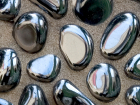A molecular glance on solar water splitting
The hunt for electron holes
Hydrogen production by solar water splitting in photoelectrochemical cells (PEC) has long been considered the holy grail of sustainable energy research. Iron oxide is a promising electrode material. An international team of researchers led by Empa, the Swiss Federal Laboratories for Materials Science and Technology, have now gained in-depth insights into the electronic structure of an iron oxide electrode – while it was in operation. This opens up new possibilities for an affordable hydrogen production from solar energy.

|
(Image source: iStock) |
||||
|
Hematite, the mineral form of iron oxide (or trivially, rust), is a promising anode material for photoelectro-chemical cells (PEC) because of its affordability, availability, high stability and good spectral match to the solar spectrum. Although it has the potential of a 15% solar-to-hydrogen energy conversion efficiency, its actual efficiency is lower than that of other metal oxides. This is due to hematite’s electronic structure, which only allows for ultrashort electron-hole excited-state lifetimes.
However, the electronic structure of hematite is such that the photo-generated holes tend to recombine with the electrons before reaching the surface. As a result, the resulting photocurrent is limited by the relatively few holes that actually do reach the surface. Recent efforts to optimize the nanostructured morphologies of hematite photoanodes have led to significant improvements in performance, but in spite of these efforts, the overall energy conversion efficiency in hematite remains at only about a third of its potential. An intelligent management of electron and hole transport is, therefore, critical for a better materials performance. |
||||
|
In this context, a better understanding of hole states at the hematite surface has been the subject of much interest as well as debate. It has long been suspected that in hematite, two types of holes with different water-splitting power are formed. The existence of different types of holes with disparate reactivity toward water oxidation has broad implications for the ultimate performance of hematite. But it is quite difficult to detect such holes, and studies of this phenomenon are complicated by numerous technical constraints. Moreover, the holes are transitional and quite elusive.
|
||||
|
||||
| Their groundbreaking experiment demonstrated the formation of two different types of electron holes at the semiconductor-liquid interface under the exact conditions, at which the photocurrent arises. Quantitative analysis of their spectral signatures revealed that both types of holes, contrary to earlier speculation and historical perception, contribute to the resulting photocurrent. «This is a milestone in the understanding of solar water splitting and encouraging news for researchers worldwide who are working to optimize hematite for PEC photoanodes», says Braun. | ||||
|
|||
|
|||
|
|||

